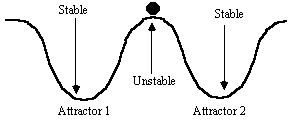
Self-organization theory is a branch of systems theory that relates to the process of order formation in complex dynamic systems. Drawing from the fields of cybernetics and gestalt psychology, self organization theory offers a new paradigm for perception and change. Many of the most recent and significant developments in self organization theory (especially those related to applied psychology) have been spearheaded by Dr. Peter Kruse at the University of Bremen, in Germany.
Paradoxically, self-organization theory arose from the study of chaos. Scientists studying chaos (the absence of order) noticed that when enough complexly interacting elements were brought together, rather than create chaos, order seemed to 'spontaneously' form as a result of the interaction. In our nervous system, for instance, self-organizing processes are thought to be the result of massive associative connections between our nerve cells. These associations are thought to be established and elaborated according to the 'Hebb' rule. Hebb was a Nobel prize winning neurologist that discovered if two interconnected neurons in a similar state respond simultaneously, their connection is strengthened. In other words, rather than a 'beaten path' established by physical force, the strength of the associative connections between the parts of our brain and nervous system is determined by a kind 'rapport' between the nerve cells. [The Hebb rule may even be at the root of the basic strategy for establishing rapport in NLP, which involves the 'mirroring' of another person's behavioral or cognitive patterns.]
Rather than being robotically controlled by external 'stimuli' which produce mindless, reflexive reactions (as in the models of Pavlov, Skinner and the Behaviorists), self organizing systems organize their own behavior in relation to certain focal points in their environment. According to 'self-organization' theory, order in an interconnected system of elements arises around what are called 'attractors', which help to create and hold stable patterns within the system. These attractors form a kind of 'landscape' that shape and determine patterns of interaction within the system. Figure 1 illustrates a simple landscape made of two 'attractors', represented as two valleys or 'basins'. If one imagines that the ball shown in the diagram is able to move over the landscape, it is easy to visualize how the bottoms of the valleys would make a very stable location for the ball. The ridge where the ball is sitting, however, would be a very unstable location. If the ball were resting at the bottom of one of these valleys, it would take much more energy to move it to a new location than it would if the starting state of the ball were in the unstable location.

In many ways the mental and emotional fabric of our lives could be viewed as such a landscape. Perceptual "attractors," for example, are the focal point in a phenomenon around which the rest of our perceptions become organized. Consider the 'stimulus' provided by figure 2. Is it an image of a young woman wearing a necklace or old woman with her head bowed?
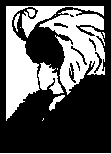
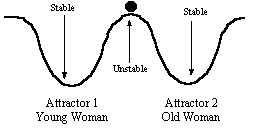
Of course, the picture itself is simply a complex combination or 'landscape' of lines and light and dark areas. The women, young or old, are not really on the paper, but rather in our minds. We "see" a "young" or "old" woman because of basic assumptions and deep structures within our own nervous systems - what Aristotle referred to as "formal causes." To move between the 'images' in the 'landscape' we need to first destabilize our focus on one attractor and subsequently restabilize or 'fixate' our attention around the new attractor.
Some other examples of 'attractor landscapes', are shown in figures 3 and 4. The first group shows the face of a man transforming or "morphing" into the body of a woman. At the extremes the two images are clear and 'stable'. The intermediate images become progressively more ambiguous. In the middle, it is more difficult to "fix" upon one particular image.
Again, the experience of "man's face" or "woman's body" are not in the marks on the paper but in our own nervous system (a bee or a dog would not be likely to recognize either image).
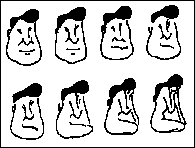
Figure 4 shows a transformation between the words "endure" and "change" as two verbal 'attractors'.
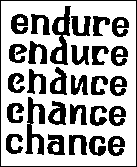
Of course, 'attractors' are not only a perceptual phenomenon. They occur in other forms as well. For example, a similar process seems to be behind the neurological mechanisms by which we are able to establish different 'parts' of ourselves within the same nervous system. As an analogy, the images of the women in the earlier picture would be like two 'parts' of a person. Under certain circumstances, a person's nervous system could self organize to bring a 'younger' part into the foreground. In other situations, the 'older' part could be in the foreground.
The NLP conception of an "imprint" is also quite similar to the notion of an 'attractor'. Of course, in self organizing systems, the 'force' of the "attraction" does not actually come from the object or event outside of the system, but is rather the result of the interaction between the system and its environment. 'Attractors' are simply an external reference point around which the rest of system organizes its activity. For example, for a newly hatched duckling, 'movement' is the initial attractor around which the nervous system of the duckling begins to form the rest of its representation or "imprint" of 'mother'.
According to self organization theory, internal states (either problem states or states of excellence) would be considered patterns of organization within the nervous system of the individual which could be 'self organized' and maintained under certain conditions. Aspects of the events in which these states first occurred could become anchors or 'attractors' around which the state would spontaneously self organize and reoccur later on. Thus, events and "imprints" function as the initial "attractors" for our later models of the world; both drawing out experiences and collecting them into memory. These collections of representations then become an "attractor" themselves for the next level of organization.
In self organization theory, the 'strength' of an attractor is described in terms of the 'depth' and 'width' of its 'basin'. The 'depth' of the basin relates to the intensity of the attraction. The 'width' of the basin relates to how easy it is to access that particular state in different situations. For example, some of our states may be very strong and powerful, but only available to us in a small number of special circumstances - like moments of inspiration that are intense but few and far between. Other states may be relatively weak, but are available to us in many different circumstances - such as short moments of irritation or doubt which may occur in a variety of situations but are easily overcome.
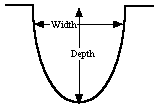
Thus, a basin that is 'deep' but 'narrow' would be a strong state that we only experience on occasion. A 'shallow' but 'wide' basin would be like a state that we are able to experience in many different situations, but which is not very intense. A 'shallow' and narrow basin would represent a very transient state that we experience only rarely and not very strongly. A 'deep' and 'wide' basin would be a state that is intense and easy to get to in a variety of different circumstances.
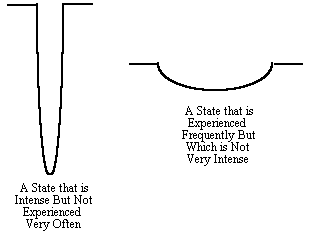
The individual 'attractor landscapes' of our own lives would depend to a certain degree on the influence of our personal histories. For instance, a person who has experienced a traumatic event, but in a very unusual circumstance, might develop a very intense reaction (a 'deep' basin) but only in very specific circumstances (a 'narrow' width). Someone who has a phobia of going over a specific bridge would be an example of this. A person who has had a frightening experience but in a more common situation might have an intense reaction as well, but experience it more often and in more contexts (its basin is 'wider'). This would be more like the situation of a person who has something like agoraphobia (fear of going out of doors).
Establishing a 'metacognition' or 'meta position' with respect to challenging past experiences could be viewed as a way to help make the 'attractor basin' of those particular experiences 'wider' (available to our conscious awareness in more circumstances) but also more 'shallow' (lowering the emotional affect associated with the experience).
Within the metaphor of a 'landscape', change processes could be viewed in one of two ways; 1) surface level or 2) deep level changes. 'Surface' level change would involve moving the ball to a different part of the landscape; but leaving the landscape unchanged. Trying to ignore a bad feeling and stay optimistic would be an example of attempting to move the ball of one's 'consciousness' to a different part of one's mental or emotional landscape. Change at the level of 'deep structure' would involve modifying the landscape itself by actually altering the 'attractors' or the attractor 'basin'. Finding the source of the bad feeling and transforming by 'reimprinting' for instance, would be an example of this level of change.
The basic process of deep level change in a self organizing system involves first 'destabilizing' the existing attractors which hold the system in its present state, and then introducing or activating a new attractor that will alter the 'landscape' of the system. In self organization theory, the resulting change in the landscape is considered to be produced or 'unveiled' through the process of 'iteration'. This is because self organizing systems tend to impact their environment by continually attempting to manifest their own internal deep structures. Looked at from this perspective, solutions to problems emerge organically through successive cycles of iteration - similar to Freud's notion of "associative correction." A strong representation of a goal, for example, can be an "attractor" for possible resources and solutions (in the form of a T.O.T.E. loop). Each stage of the process of achieving that goal is another 'iteration', building upon the previous ones, until the final product is produced; much like organic growth in nature or a mathematical fractal.
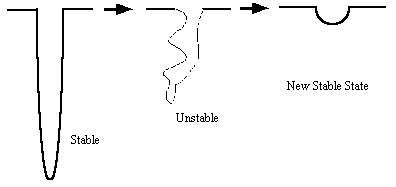
In NLP, 'attractor' type phenomena are believed to occur with respect to the 'submodalities' of the various sensory representational systems. The submodality characteristics of an experience determine much about the type and degree of affect that experience will have for a person. In other words, it is not only the content of a particular experience or memory that will determine how a person responds, but the formal characteristics of the representation of that experience. The same image, for example, may be experienced as either attractive or repulsive depending on certain submodality characteristics. An inviting image of a slice of chocolate cake may seem less inviting if the color of the cake is suddenly changed to green, for instance.
As another example, there was a time in my mother's process of healing her cancer in which an image came into her mind of a demonic looking creature dressed in black that threatened her and made her feel doubtful and afraid. She tried to block the image and put it out of her mind; but it kept returning. It was as if this image had become an 'attractor' for her fears and doubts. (In the metaphor of a 'landscape', this creature was like a hole or ditch along the path of her healing. She would try to roll the ball out of the middle of the basin, but as soon as she stopped efforting, the ball would roll back to the bottom.)
Rather than blocking out the image, I invited my mother to explore the positive purposes of fear and doubt. She realized that the positive intention of both of them was to protect her and to make sure she was taking care of herself. Having understood and acknowledged those intentions we decided to use a more appropriate 'attractor'. Rather than simply trying to make the old one go away, we adopted a strategy of 'pacing and leading'. I first asked her if she could just make the image of the demonic figure slightly smaller. She was able to do this and, when she did, its affect became a little less. I then asked if she could make the image two-dimensional - not change the content of the image, but simply make it two dimensional. She was also able to do that, which lessened the affect even more. I then asked if she could put a frame around it. She did. Finally I asked if she could change its color. She imagined the figure in a bright yellow outfit. At this point the image of the creature had become so laughable and harmless to her that it just seemed to disappear on its own_never to return. In place of this creature my mother decided to insert the image of a 'guardian angel'. To make the image of this angel powerful and 'attractive', she made the image large, three-dimensional, bright and glowing with light. This new image would also satisfy the positive intention of protecting her and making sure she was taking care of herself, but the affect, of course, was quite different.
Similar processes, like the EMDR (Eye Movement Desensitization and Repatterning) technique for dealing with post-traumatic stress, also essentially involve interrupting patterns that are highly stable because they are blocked, "strangulated" or 'frozen'. The EMDR process, for instance, involves having a person move his or her eyes back and forth rapidly while thinking of a frightening or traumatic event. The movement of the eyes in effect 'scrambles' or destabilizes the representation. Providing the person has other resources available, this destabilization will often lead to 'associative correction' without further intervention on the part of the facilitator.
Self-organization theory offers a powerful and refreshing alternative to the typical 'mechanistic' views of human behavior put forward by Behaviorism and many aspects of NLP. The metaphor of a 'landscape' also provides a more systemic and organic explanation for how many NLP techniques work (see Strategies of Genius Volume III). The principles of self-organization also provide a rich source for more generative and ecological applications of NLP by placing the source and power for healing and change within (rather than outside of) the individual.
For more information on Self-Organization:
Synergetics of Cognition, H. Haken & M. Stadler (Ed.), Springer-Verlag, Berlin, Germany, 1989. For information on Robert Dilts’ products and services, please see Upcoming Seminars or Robert’s Product Page or return to Home Page.
If you have problems or comments concerning our WWW service, please send e-mail to the following address: michaelp@bowsprit.com.
This page, and all contents, are Copyright © 1998 by Robert Dilts., Santa Cruz, CA.
Conclusion
Self Organization Theory Meets NLP (video), R. Dilts & P. Kruse, NIK, Ausser der Scheifmuhle 67, 28203 Bremen, Germany, 1994 (Fax: 49-421-33 55 843).
[This article includes material excerpted from Strategies of Genius Volume III, by Robert Dilts, Meta Publications, Capitola, CA, 1995.]
Also see the NLP Pattern
of the Month or the Archives if you are interested in checking out NLP in more depth.
You also may want to visit the Anchor
Point Page. Anchor Point is the practical journal of NLP.